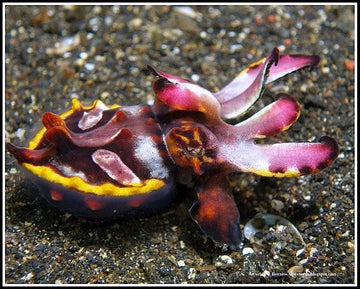The flamboyant cuttlefish (Metasepia pfefferi) is a remarkable cephalopod, favored and sought after by underwater photographers and divers. What stands out most about this cuttlefish are its striking colors with changing and unusual patterns and its ability to walk on the seafloor, making it the only species of cuttlefish capable of doing so.
This small cuttlefish measures a maximum of 8 centimeters and has three pairs of fleshy papillae along its body or mantle and above its eyes. Flamboyant cuttlefish also have papillae that form two "Vs" on the dorsal side. Papillae are also present above their eyes. All these papillae are used for camouflage and allow them to change shape and size when they feel threatened. When disturbed or when they are about to capture prey, they quickly change color to a wavy pattern of black, dark brown, and white with yellow spots all over the mantle, displaying bright red on their arms and eye papillae. This colorful display indicates the venomous nature of this cuttlefish, the only venomous one of its kind. In fact, according to research conducted by marine biologist Mark Norman, one of the world's leading experts on cephalopods, this cuttlefish contains a toxin as lethal as that of the blue-ringed octopus.
Flamboyant cuttlefish have 8 arms with four rows of suckers that hide two tentacles used to capture prey, primarily crustaceans and small fish, which, unlike most cephalopods, they hunt during the day. Both tentacles are of a deep bluish-white color that is very conspicuous. One of the two tentacles is modified and is used for reproduction.
The well-chosen name "flamboyant" (which could be translated as "colorful" or even "extravagant") comes from the beautiful color changes produced by its skin due to cells called chromatophores, leucophores, and iridophores, small ink-filled structures with color that it uses to communicate, whether to impress a potential predator, for mating rituals, or to mark territory against another of its species.
Flamboyant cuttlefish live on sandy bottoms and in muck diving areas within the Coral Triangle regions: Indonesia, Malaysia, the Philippines, Papua New Guinea, and northern Australia.





















